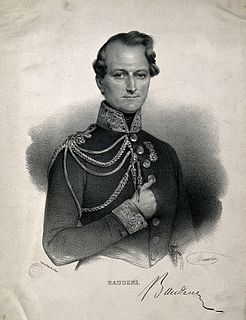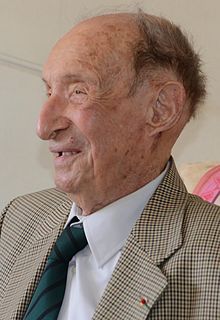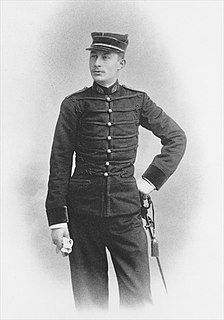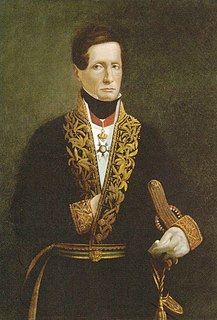 W
WLucien Jean-Baptiste Baudens was a French military surgeon.
 W
WJean-Marie Bayol was a French army doctor, colonial administrator and politician.
 W
WLouis Jacques Bégin was a French military physician.
 W
WJacques Bizet was a French physician and businessman best known for his childhood friendship with the novelist Marcel Proust, whom he predeceased by fifteen days when he committed suicide. The composer Georges Bizet was his father. His mother was the literary hostess, born Geneviève Halévy. The essayist-historian Daniel Halévy was a cousin.
 W
WCharles Clément Burlureaux was a French physician and psychiatrist. He also worked as an associate professor at Val de Grâce in Paris. Buruleaux was born in Dijon, France on July 24, 1851 and died on January 18, 1927.
 W
WGuy Charmot was a French military doctor and member of the French resistance during World War II.
 W
WRené-Nicolas Dufriche, baron Desgenettes was a French military doctor. He was chief doctor to the French army in Egypt and at Waterloo.
 W
WÉtienne Destot was a French radiologist and anatomist who was a native of Dijon. He studied medicine in Lyon, and later worked in the hospitals of Hôtel Dieu, Croix-Rousse and Charité in Lyon. In addition to his work in medicine, he was an accomplished sculptor.
 W
WAnne Murray Dike (1878-1929) was an American doctor, chair of the American Committee for Devastated France from 1917 and recipient of the Croix de Guerre and member of the Legion of Honour.
 W
WErnest Duchesne was a French physician who noted that certain molds kill bacteria. He made this discovery 32 years before Alexander Fleming discovered the antibiotic properties of penicillin, a substance derived from those molds, but his research went unnoticed.
 W
WBaron Guillaume Dupuytren was a French anatomist and military surgeon. Although he gained much esteem for treating Napoleon Bonaparte's hemorrhoids, he is best known today for his description of Dupuytren's contracture which is named after him and which he first operated on in 1831 and published in The Lancet in 1834.
 W
WFrançois Fournier de Pescay, was a French physician and surgeon.
 W
WNicole Girard-Mangin was the first female doctor to serve in the French Army. She served in several roles during the entire First World War. She was also a specialist in tuberculosis (TB).
 W
WPierre Huard was a French physician, historian of medicine and anthropologist, long in post in Indochina, dean of several faculties of medicine, rector of the Université Félix Houphouët-Boigny, a pioneer in the history of medicine.
 W
WJean-Baptiste Feuvrier was a French military physician, who, from August 1889 to October 1892, served as the personal physician to Naser al-Din Shah Qajar, King (Shah) of Qajar Iran. He wrote a travelogue about his life in Iran, the Trois ans à la cour de Perse. Prior to his appointment in Iran, he served as a personal physician to Prince Nicholas of Montenegro.
 W
WBaron Dominique Jean Larrey was a French surgeon in Napoleon's Grande Armée and an important innovator in battlefield medicine and triage. He is often considered the first modern military surgeon.
 W
WRené Primevère Lesson was a French surgeon, naturalist, ornithologist, and herpetologist.
 W
WAntoine Louis was an 18th-century French surgeon and physiologist.
 W
WAmbroise Paré was a French barber surgeon who served in that role for kings Henry II, Francis II, Charles IX and Henry III. He is considered one of the fathers of surgery and modern forensic pathology and a pioneer in surgical techniques and battlefield medicine, especially in the treatment of wounds. He was also an anatomist and invented several surgical instruments. He was also part of the Parisian Barber Surgeon guild.
 W
WMadeleine Jeanne Marie Pauliac was a French doctor and a member of the French Resistance. Her experience in post-World War II Poland formed the basis for the movie Les Innocentes.
 W
WJean René Constant Quoy was a French naval surgeon, zoologist and anatomist.
 W
WHenri Jules Louis Marie Rendu was a French physician born in Paris. He was related to glaciologist Louis Rendu (1789–1859).
 W
WÉdouard Rist was a French physician who specialized in tuberculosis research (phthisiology). He was the brother of economist Charles Rist.
 W
WCharles-Emmanuel Sédillot was a French military physician and surgeon. He was the son of orientalist Jean Jacques Emmanuel Sédillot (1777–1832), and an older brother to historian Louis-Pierre-Eugène Sédillot.
 W
WJacques Solomon was a French physicist and Marxist who played a central role in the debate over quantum mechanics in France in the 1930s and 1940s. He was killed by firing squad at Fort Mont-Valérien in 1942.
 W
WSolange Troisier was a French physician, Inspector General of Prisons, and deputy for the Val-d'Oise. She was a left-wing Gaullist, a feminist, and was active in many committees on social issues.
 W
WJean-Baptiste-Joseph-Anne-César Tyrbas de Chamberet was a French military physician.
Louis Vaillant was a French army doctor, naturalist, and explorer. He was the second son of Léon Louis Vaillant, professor of zoology at the French National Museum of Natural History in Paris.
 W
WJean-Antoine Villemin was a French physician born in Prey, Vosges. In 1865 he demonstrated that tuberculosis was an infectious disease.
 W
WJean Hyacinthe Henri Vincent was a French physician who was a native of Bordeaux. He was an associate professor at Val-de-Grâce, as well as medical inspector general with the French Army. Later he attained the chair of epidemiology at Collège de France.